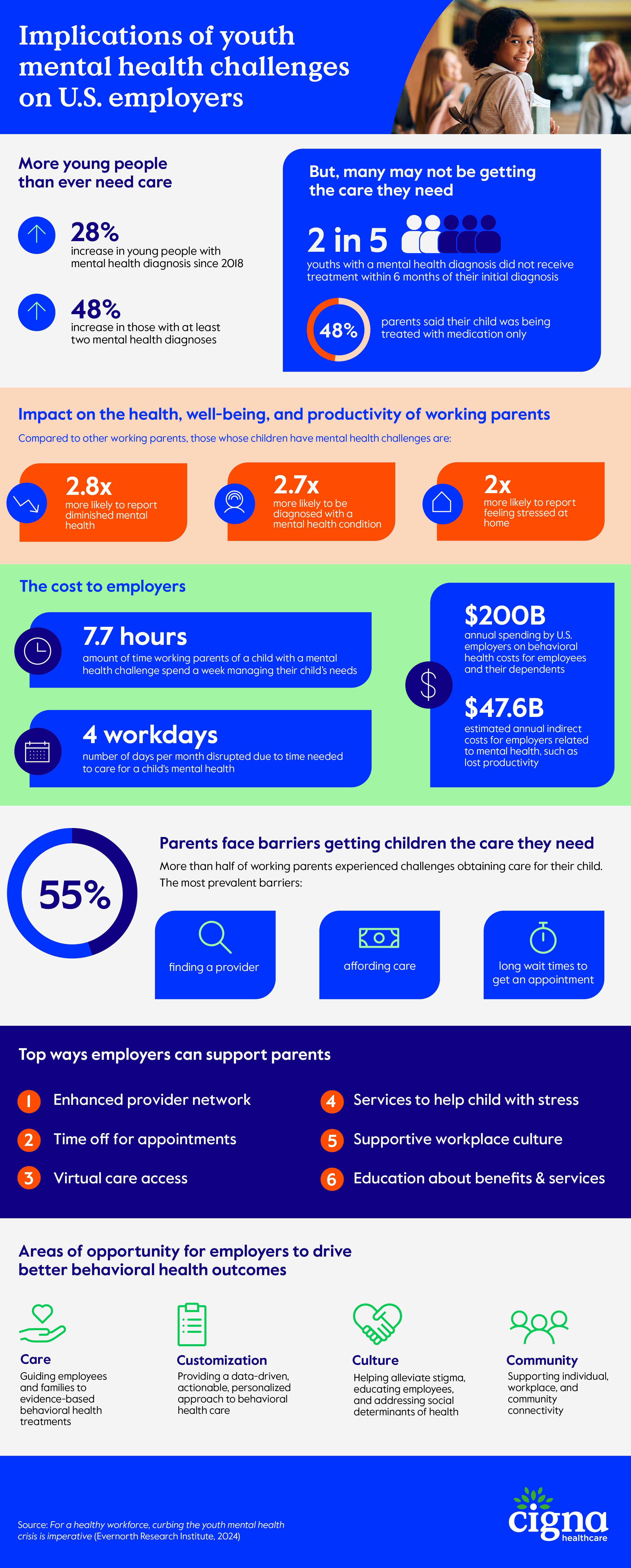New research highlights the state of youth mental health and the depth of challenges facing working parents who care for young people with mental health issues – and what more employers can do to help.

Click on the image to enlarge
The COVID-19 pandemic imposed unprecedented levels of change and uncertainty for young people and exacerbated an already growing youth mental health crisis in the United States.
Diagnosed or undiagnosed, millions of young people are struggling, and many parents feel ill-equipped to manage the many related challenges impacting life at home and work. The soaring human and economic costs make the ongoing crisis and the ripple effect on parents, families, communities, and workplaces untenable for a healthy, thriving society. U.S. employers spend more than $200 billion annually on behavioral health costs for employees and their dependents, a figure that excludes indirect costs such as lost productivity and missed work.
“Employers can change the trajectory of the youth mental health crisis through differentiated health insurance and benefits design, a supportive workplace culture, and through community engagement,” said Jason Youngblood, director of the Well-being Center of Excellence at Cigna Healthcare and a licensed behavioral health clinician. “Employers are well-positioned to help address current trends.”
New research from the Evernorth Research Institute along with survey data from YouGov commissioned by Evernorth, the health services division of The Cigna Group, dives deep into the prevalence of youth mental health challenges and treatment trends.
The research titled, "For a healthy workforce, curbing the youth mental health crisis is imperative," also provides insight into the depth of challenges facing working parents who care for young people with mental health issues – and what more employers can do to help.
Let's take a look at some of the key findings.
Many young people are not receiving the full spectrum of behavioral health care
In 2022, 38% of young people did not receive any follow-up treatment within six months of initial diagnosis. Of those who did receive treatment, a significant number were treated with medication only. In the survey of parents with children experiencing mental health challenges, 48% said their child was being treated with medication only.
According to the American Academy of Child and Adolescent Psychiatry, medication use in children should be considered as part of a holistic and collaborative mental health treatment plan. When youths are receiving medication only, adding therapy – individual or family – could provide an opportunity to improve and sustain health outcomes.
Working parents face barriers to getting their children the mental health care they need
Behind every young person, every prescription, and every appointment is often a parent trying to help their child feel better. Parents face a barrage of questions about whether their child needs care and if so, what type of care, how they can obtain care, and the costs involved. More than half of working parents (55%) in our survey experienced challenges obtaining care for their child. They reported difficulties finding a provider, affording care, and getting an appointment within a reasonable time frame.
Working parents are struggling with their own mental health
Working parents with children struggling with their mental health were about twice as likely as parents of children without mental health challenges to report feeling stressed at home (48%). They also reported accomplishing less (51%) and having cut down on time spent on personal activities (40%) and social activities (36%).
While the research did not look at causality, working parents caring for a child with mental health challenges are far more likely to have mental health struggles of their own, with 54% reporting a diagnosed mental health condition. They are also lonelier, less resilient, less likely to feel a sense of community belonging, and have lower vitality.
The more time a parent spends caring for a child’s mental health needs, the greater the disruption to their work
Parents of a child with a mental health challenge reported lower job satisfaction, found their jobs significantly more stressful, and felt less able to carry out their job duties. On average, these working parents spend about eight hours a week (7.7 hours) managing their child’s mental health needs.
Managing a child’s needs includes activities like looking for appointments, communicating with school staff, and learning about their child’s condition. On average, this disrupts up to four workdays a month, which can take the form of starting work late, leaving work early, or missing a full day of work.
Employers can do more to support parents managing youth mental health challenges
Parents want their employer to offer benefits, services, support, and a workplace culture that makes managing their children’s mental health issues easier. They prioritize a strong provider network, time off for appointments, access to virtual care, services to help their child with stress, and a supportive workplace culture.
Ensuring employees know how to recognize distress in children and when, where, and how to get the help they need builds confidence and increases the likelihood that parents will obtain help for their children and themselves.
Areas of opportunity for employers to drive better behavioral health outcomes
The research outlines some key areas of opportunity for employers to drive better behavioral health outcomes across care delivery, customization, culture, and community engagement.
- Care delivery: Design a benefits approach that guides employees and families to evidence-based behavioral health treatment that integrates medical, behavioral, and pharmacy care, mitigating the potential for siloed treatment.
- Customization: A data-driven, actionable approach to behavioral health care allows for personalized plans to assess, treat, and offer better care at every touchpoint.
- Culture: Cultivate an environment that helps alleviate stigma, educates employees and managers, and acknowledges and addresses social determinants of health (SDOH).
- Community engagement: Employers can support individual, workplace, and community connectivity to address some of the underlying drivers of mental health challenges.
“For employers, the benefits of a healthy, productive workforce extend beyond lower health care costs,” Youngblood said. “Increased employee engagement, greater commitment to the company, and higher retention all contribute positively to business results. Employers cannot afford for the youth mental health crisis to continue its current trajectory.”
Cigna Healthcare is committed to improving youth mental health
We’ve made important progress expanding access to evidence-based, quality, in-network therapy for millions of people through the Evernorth Behavioral Care Group, launching an innovative measurement-based care program for our behavioral health network, expanding and promoting utilization of virtual care, and advocating for self-identification in specialty areas including those working with children and teens.
We know that the impact we want to have cannot be done through health care and services alone. We need to engage young people in the communities where they live, play, and go to school, and recently launched a new community initiative to improve youth mental health as it relates to post-pandemic acute stress and distress. This commitment includes support for those who care for youths in everyday settings and interactions such as parents, caregivers, and educators.

Employers can take steps to curb the youth mental health crisis
New research looks at the state of youth mental health, challenges facing their working parents, and how employers can improve family behavioral health care.
This article was created with the assistance of AI tools. It was reviewed, edited, and fact-checked by Cigna Healthcare’s editorial team and subject matter experts.
